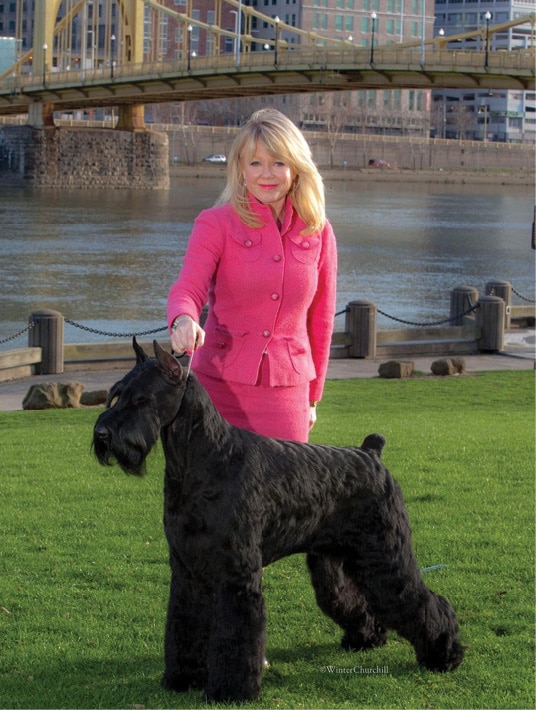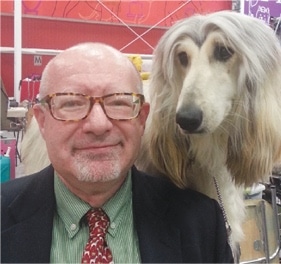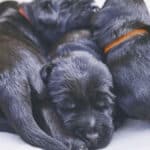Showsight’s Allan Reznik sat with AKC Judge and Breeder Vicki Seiler-Cushman who shared these insights on her journey in our community and sport.
Where did you grow up?
I grew up in Pittsburgh, Pennsylvania, then moved with my mother to North Olmsted and Olmsted Falls, Ohio, in junior high. My father and family continued to live in Pittsburgh, so I still had a deep connection to the city, calling it my hometown.
Do you come from a doggy family? If not, how did the interest in breeding and showing purebred dogs begin?
Vicki Seiler-Cushman: My mother and I began breeding and showing Siberian Huskies in 1970. She also bred a couple of Doberman Pinscher litters. She started our line with the kennel name of Cimmaron, and our last litter together was born in 2000. Along with breeding Siberians with my mother, I bred a litter of Golden Retrievers and co-bred several litters of Boston Terriers and Chihuahuas.
Who were your mentors in the sport? Please elaborate on their influence.
Vicki Seiler-Cushman: George Rood, first and foremost. I worked for George as his assistant from the age of 12 until I was 21 years old. I managed all of his kennel operations, from training and billing to the care of the dogs. He was a great handler of all breeds, but most importantly, Dobermans, Boston Terriers, Boxers, Dachshunds, Weimaraners, and Min Pins. I met many great influencers during my time with George as they were his close friends; people such as Dick Cooper, George Ward, George Heitzman and Barbara Alderman, Bobby Barlow, Tom Glassford, Charley Cooper, David Bolus, Jane Kay, Max Riddle, Joe Napolitano, Carlos Rojas, and Pam DeHetre. It was a wonderful time in dogs, but also a lot of hard work as the travel was much different back in those days. Watching the greats in the sport present their dogs—Les and Denny Kodner, Bob and Jane Forsyth, Toddie and Houston Clark, Mike Leathers (Billings), John McNamara, Porter Washington, Buddy Dicke, and Pat Craige Trotter (whom I still enjoy to this day)—was a real gift to a young child.
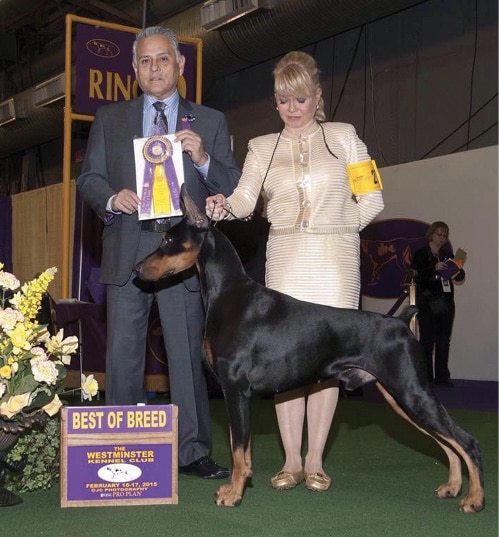
Showing dogs in the 1970s and ‘80s, you traveled every day to a different city as AKC required that the clubs’ shows be held in the same city that a club represented. It was very hard on the dogs and the exhibitors. There were no clusters held in one spot as we enjoy today, so at the end of each day we were loading all of the equipment, driving in caravans to the next show site, and always stopping for dinner along the way. The shows began no earlier than 9 a.m., so we set up at the site every morning in the new location. There was a warm camaraderie in the group; in the ring we were competitors, absolutely, but still close like family.
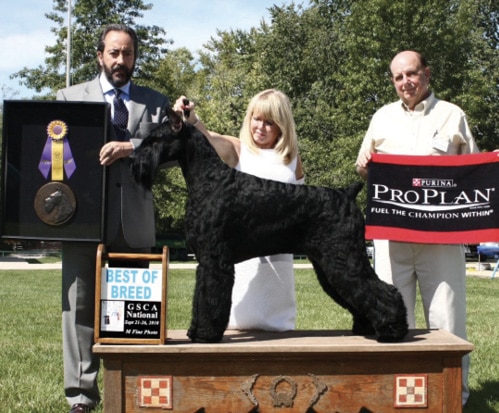
Barbara Alderman is someone I’ve known since I was 12 years old. I have always admired her. She’s been a great teacher to me in many breeds and also on judging. Today, she is still my mentor.
Bill Shelton is a dear friend who is like a brother to me. Any questions on breeds, judging, breeding, and for many other connections in our lives, he is my go-to for “phone a friend.”
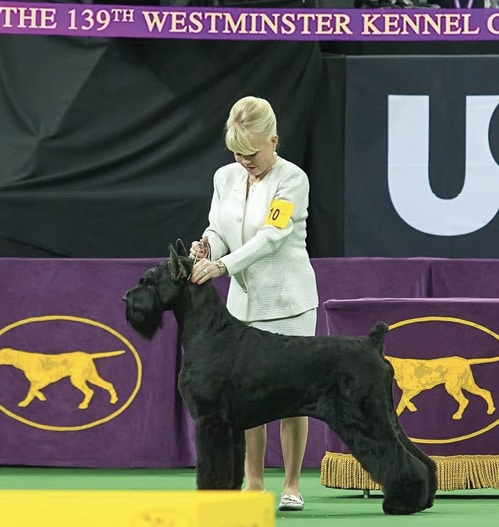
Judy Doniere and I traveled together to Westminster and the Doberman National every year, and she was a constant mentor when we lived near each other in Ohio. She was a big influence in my Doberman career.
Jane Kay was the woman in the men’s group. I had so much admiration for her as she was like a mother to all the assistants. She cared about them when most others just saw them as invisible. Plus, she had a wicked golf game and was a powerful force in what was then considered a man’s world.
When I worked for George, Pam DeHetre was the up-and-coming Doberman handler. She was tough and successful. She has always been in my life, providing advice, support, and words of encouragement.
Sylvia Hammarstrom has been a wonderful resource on breeding and conditioning dogs. I am lucky to have her as a friend and mentor. She is a fireball of energy and knowledge.
Meredith Johnson Snyder’s knowledge and devotion to Cavaliers across the world was energizing. She always drove me to work harder and smarter.
Many people associate you with Dobermans, but they were not your first breed. What breed did you begin with?
Vicki Seiler-Cushman: I began in Siberian Huskies, when I was in grade school. We actually owned German Shepherd Dogs before then. George Rood always told me not to breed the dogs that were your main focus as it would be a conflict for your clients. So, I arranged many breeding programs in Dobermans; arranged for stud dogs and graded litters.
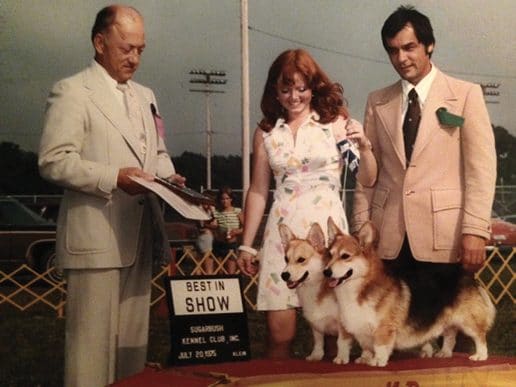
I then owned Pointers with Michael Zollo as my own breed, then Golden Retrievers, and I co-bred Boston Terriers and, now, Chihuahuas. I own one Doberman that we plan on breeding this year.
How many dogs do you currently house? Tell us about your facilities and how the dogs are maintained?
Vicki Seiler-Cushman: I have three Chihuahuas that live at home, and I co-own three others that live with their co-owners. I own one Doberman with my son that we plan on breeding this year.
Who were some of the most significant show dogs you were associated with over the decades? What moments stand out as the most memorable?
Vicki Seiler-Cushman: There was a beautiful Chinese Shar-Pei, Ch. Grayland’s Starlight Margaret, that broke the BIS record, and the top-winning Cavalier King Charles Spaniel, Ch. Rattlebridge Masterpiece, that also broke the BIS record. I specialed a beautiful Group-winning Golden Retriever, Ch. Laurell’s Michaelangelo.
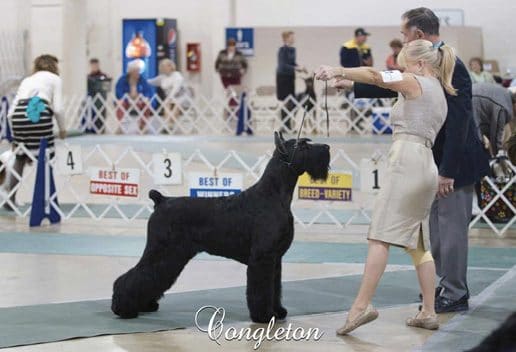
I have shown many Giant Schnauzers over the past 30 years as a professional that were ranked No. 1, all bred by Sylvia Hammarstrom of Skansen Kennel. Ch. Skansen’s I Have A Dream was the No. 1 Working Dog and won the Group at Westminster. A beautiful Akita, Ch. OBJ’s The Coal Miner, was both a top winner and a top producer. There was the No. 1 Doberman, Ch. Kamterra’s Legato, and the AKC Centennial Show’s Working Group winner, the Doberman Ch. Briarpatch Christmas Dream, who also sired many beautiful dogs. I specialed a top Rottweiler, Ch. Noblehaus Klark Kent. I owned and handled two BIS Pointers, Ch. Albelarm’s Bein Ean and Ch. Albelarm’s Errol Flynn.
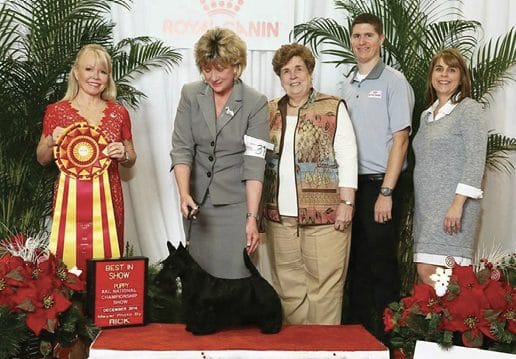
I specialed a Doberman bitch whose name many people may not recognize, but her role was of great importance. Her name was Ch. Protocol’s American Dream CDX RN AX AXJ XF ROM SchH1. She only had six puppies in her lifetime, bred just once. Out of those six puppies, five became champions. Two were Best in Show winners. Three were Top 20 conformation finalists. One was in the Top 20 for obedience. One was in the Top 20 for agility. And one was Ch. Protocol’s Veni Vidi Vici, No. 1 Working dog, Westminster Group winner, Top Twenty winner, and the winner of four National Specialties.
How did your career as a professional handler begin? Tell us about that period in your dog show life.
Vicki Seiler-Cushman: After my nine years as an assistant, I moved on to become a professional handler, with a lot of support from local judges who referred clients to me. Max Riddle, Roy Kibler, Pat and Judy Doniere, Betsy Thomas, and others were very supportive at the beginning of my career. It was difficult then, traveling by myself until I could afford to hire assistants. I was very lucky during my years as a handler to have assistants who stayed with me for many years. I can never say enough about how much help they provided and how appreciative I am.
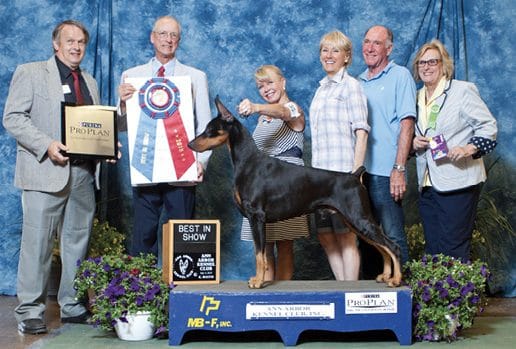
For the many newer exhibitors and up-and-coming handlers reading this, how do you establish and maintain positive, successful relationships between owner and handler?
Always be truthful, fair, and have a good line of communication. Groom, train, and condition your dogs to be the best they can be; the owners will always appreciate it.
Remember to be kind and respectful. There are a lot of options and they chose you!
The sport has changed greatly since you first began participating. What are your thoughts on the state of the fancy and the declining number of breeders? How do we encourage newcomers to join us and remain in the sport?
That is a good question, one I am working on myself. I am President of the Dayton Kennel Club and have been working on ideas for getting new members—and younger ones also. I have been looking into programs that are interesting and helpful, activities that are fun and that the members will look forward to. I plan to reach out to 4-H clubs to engage with young dog lovers who want to go a step further into breeding and showing.
If we see someone new at the dog shows, give them a great experience and encourage them to come back. Provide advice that can help them be successful!
I am also thinking of starting a non-regular class at our show for children who are breeding dogs (like Junior Showmanship, but the child must have bred the dog). If we encourage the younger generation, I see that as a win!
Where do you see your journey in dogs taking you over the next decade or two?
I am looking forward to breeding Chihuahuas and continuing my judging journey.
Vicki Seiler-Cushman | Dayton Kennel Club


